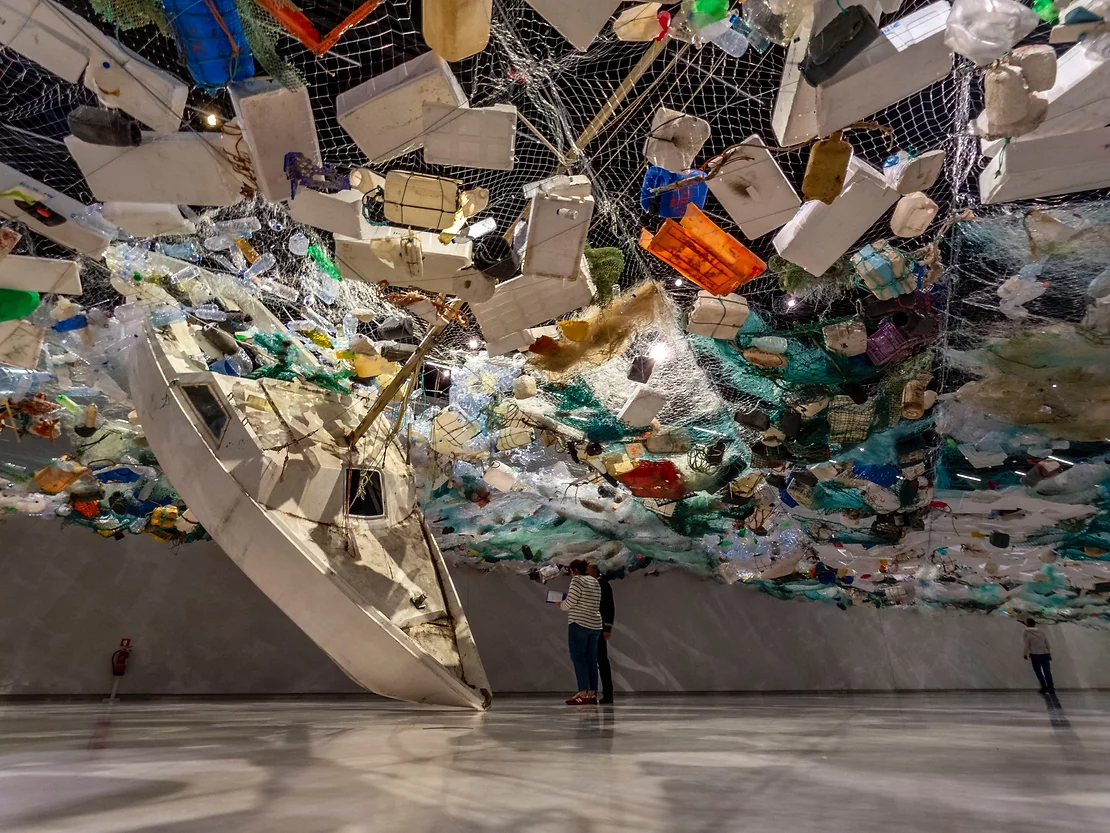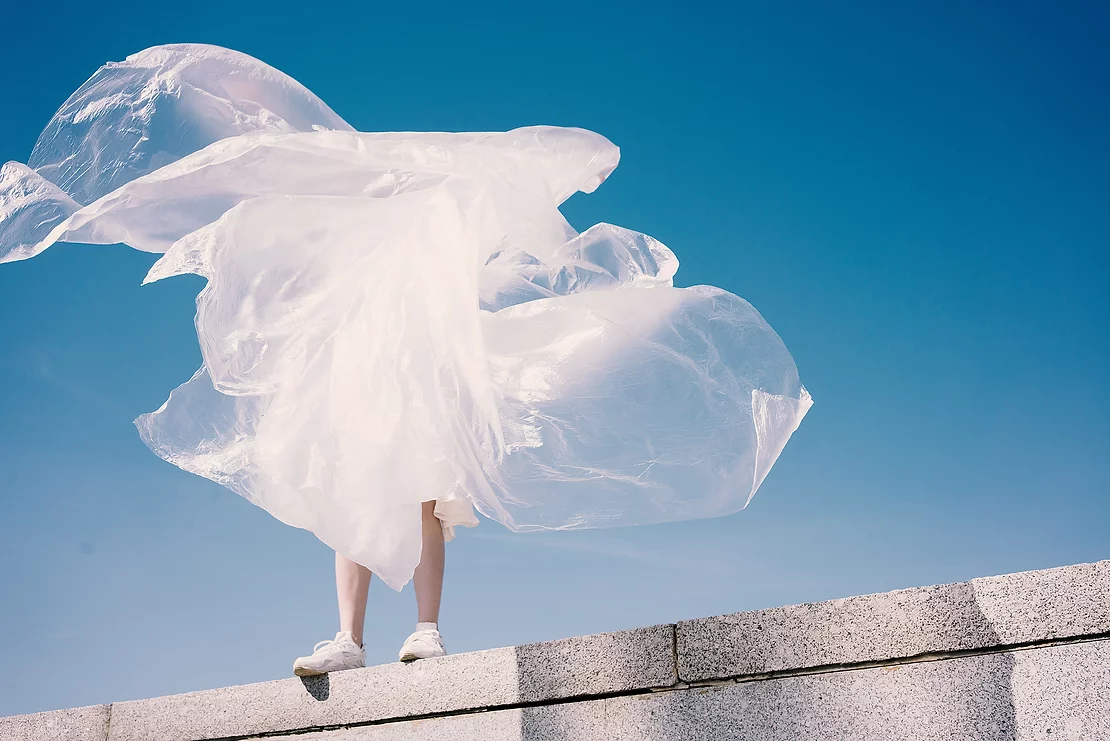What Can Be Done About Fashion’s Plastic Problem?
It can be difficult to grasp the true scale of fashion’s plastic problem. Maybe it’s the “micro” in “microfibre”, the innocuous-looking fluff you pull out of your dryer, or the largely unseen consequences of plastic-based textiles on the environment. Many of us will never see first-hand the estimated half a million tonnes of plastic microfibers — equivalent to the weight of almost 3 billion polyester tops — that end up in the ocean each year. The reality is that plastics are everywhere, from the food we eat to the top of Mount Everest, and much is still unknown about the true impact.
The industry’s plastic problem can be largely blamed on the rise of fast fashion culture. And not just its reliance on cheap plastic-based textiles like polyester, nylon and acrylic, but the dizzying rate of consumption that we’ve come to think of as perfectly normal. “The problem is not just what we're putting into the environment, it's why we're putting so much into the environment,” says Dr Tom Stanton, a lecturer in environmental science at Nottingham Trent University in the UK.
Damage is caused by plastic at every stage of its lifecycle from production to landfill. “Plastics come from petroleum,” explains Carry Somers, co-founder of Fashion Revolution. “So all the way through the supply chain you've got the carbon emissions right at the start of the process, and then you've got the microplastics that degrade over time, giving off more and more powerful greenhouse gases.” Microplastics are undoubtedly the most widespread issue created by fast fashion, which left unchecked could eventuate in 22 million more tonnes of microplastics in the ocean by 2050.
Around 80 percent of wastewater globally is completely untreated before flowing back into the natural environment. Of the water that is treated, it’s believed that 88 to 94 percent of microplastic that shed in the wash are removed. “There are microplastics that are so small that they get through the wastewater treatment plant, and then all of that sludge that's kept in the plant is usually used for fertilizer on farmer's fields anyway,” says Somers. “It's going straight onto the land and will eventually get washed out to the water table and into the rivers and sea.”
Last year, Somers joined a research voyage with the group Exxpedition, sailing from the Galapagos to Easter Island to investigate microplastic pollution. “I vividly remember arriving in Easter Island and we went to one of the few sandy beaches on the island,” says Somers. “I looked down at my feet, and it was almost half plastic and half sand. It was so shocking, a multicoloured beach.”
In the ocean, microplastics are ingested by small fish, invertebrates and insects, blocking their intestines and leaching chemicals. “Think textile dyes, flame retardants, antimicrobial agents, basically anything that's added to textiles to enhance their functionality can leech off the fibers,” says Stanton. It’s not just fish that should be worried — the average American ingests and inhales between approximately 74,000 and 121,000 microplastic particles annually — they've even been found in the placentas of unborn babies. “The impacts of this are not well understood, but there's enough for people to quite rightly be worried,” he says.
It paints a pretty grim picture, that’s for sure. It’s a problem made worse by rampant greenwashing that allows brands to conceal their use of plastics from consumers. Ed Temperley is one half of the world’s only plastic-free footwear brand WAES, based in Devon, UK. It’s a bold claim, but the WAES team know they’re the only legitimately plastic-free footwear brand because they had to invent their thread, insoles, and shoe sole foams themselves as plastic-free versions didn’t exist when they started the brand. “As soon as you look under the rug of sustainability within shoe manufacturing, you realize that frankly it’s all nonsense,” he says. “They're all either just plastic, 100 percent plastic derived from natural materials or a combination of natural materials and rubber.”
But this hasn’t stopped other footwear brands from falsely promoting their plastic-free status, says Temperley. “Everyone can just pretty much lie as much as they want in terms of their marketing, it's shocking really,” he says. “The pollution of the eco-vocabulary with greenwashing is massively damaging to the whole process of moving product development along. Why would people bother to make ethical products if you can just say you’ve made one? There’s no incentive to go and do those next steps, if you’re saying whatever you want about your products.
Temperley believes the rise of vegan fashion has increased the problem, as vegan footwear is often made from or contains an element of plastic. “The vegan movement has been an absolute boon for the plastics industry,” he says. “It’s just so easy to make something plastic and call it vegan. Likewise, if you bond an organic material [such as cactus or apple leather] to plastic material, you create this completely unrecyclable compound which is single use. How is that sustainable?”
So what can be done to fix fashion’s plastic problem? “It’s about mitigating future potential damage,” says Somers. “From what I've heard, there’s no way of cleaning up all of these microplastics in the ocean, so we definitely do have to act urgently to get to look at the root causes.” There are several approaches we can take to take, but they’ll need industry-wide commitment. “I think it comes down to a need for greater legislation, a better product so that people can buy less frequently, and a reframing of the industry so that we don't have these six-week seasons,” says Stanton.
Legislation will undoubtedly be one of the biggest steps to regulate the industry’s plastic addiction — not just from spouting unsubstantiated claims about their products, but by curbing the flow of microplastics into the environment. Last year, France introduced legislation to ensure that by 2025, all new washing machines must be fitted with filters to stop microplastics, while the EU introduced the Taxonomy Regulation to clamp down on greenwashing. It’s an approach that will ensure that every player in the supply chain is held accountable through legally binding regulations.
There are also promising tech innovations on the horizon, such as a new diamond-based process called electrooxidation that uses electrodes to attack microplastics and deconstruct them into CO2 and water molecules. Somers believes the most encouraging innovations can be found in moving away from plastic-based textiles to lab-grown cotton, created by a Massachusetts-based company called Galy. “Lab-grown cotton is going to be good for the future because it can grow without chemicals and with minimal water,” she says. “I think that's hugely exciting.” Already commercially available is Aquafil’s Econyl — a recycled nylon fabric that takes ocean waste plastic like fishing nets and industrial plastic and spins it into a new yarn.
The average consumer also has a role to play in mitigating our contribution to the problem. When it comes to shopping for clothes: “Do your research, because sometimes it comes down to people not thinking deeply enough and there’s a real big danger of oversimplifying things,” says Somers. Better yet, reconsider whether you need to buy anything at all. “It really does come back to overconsumption,” says Stanton. “We’ve become reliant on a model where we measure success by GDP, meaning the more money we can get people spending, the more we can get people consuming, the better we are perceived to be as a society. We need to stop measuring the value of something financially, and recognize the value of the environment.”


